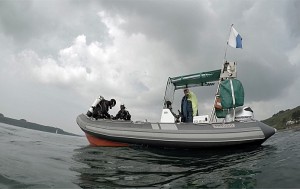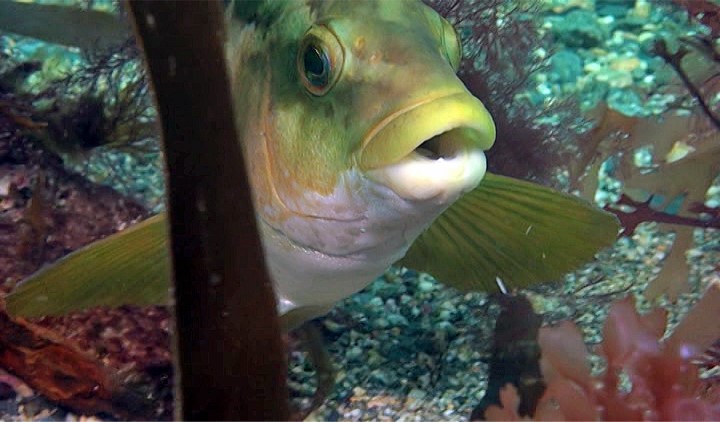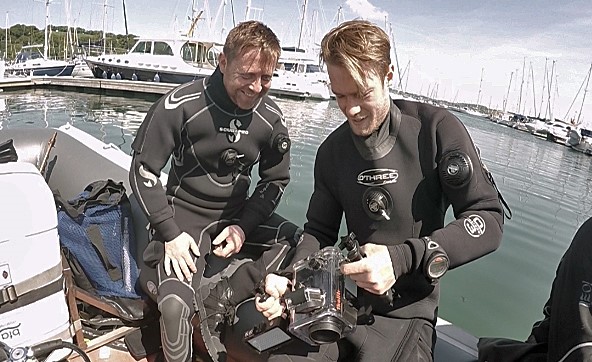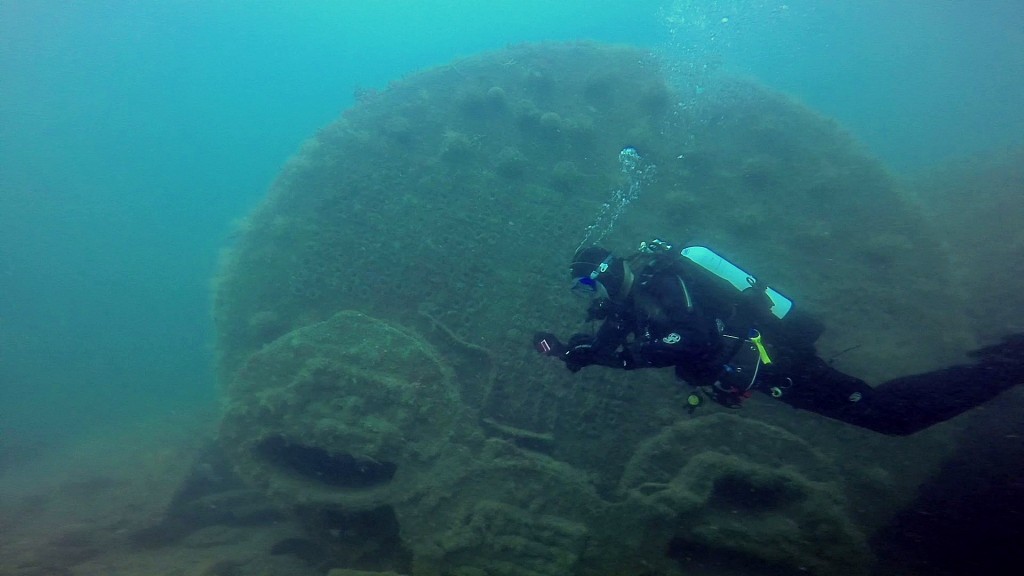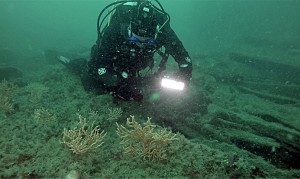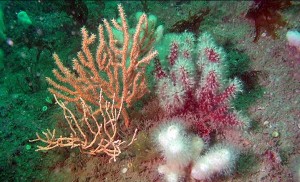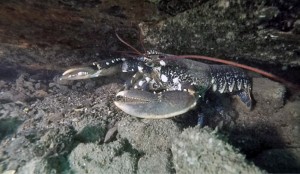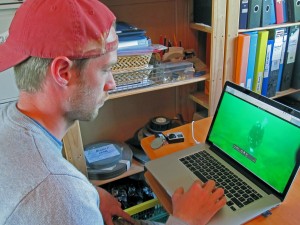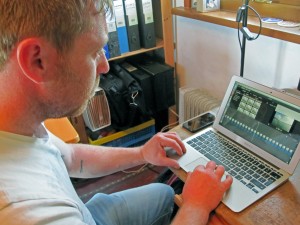News
Underwater wildlife video and editing courses in Cornwall
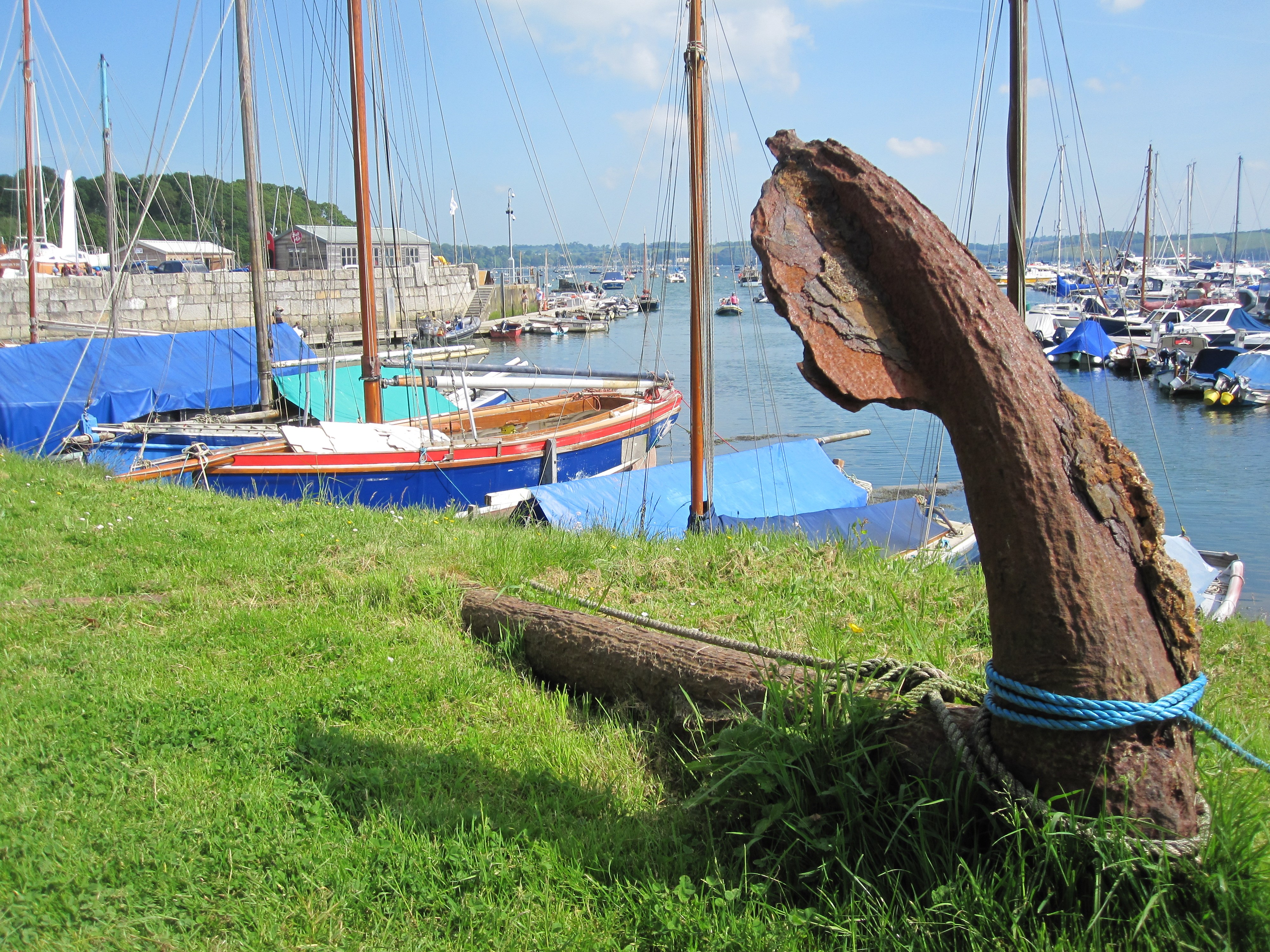
All images in this article are taken from video frames.
After an introductory lecture, we headed for Mylor in Cornwall to join Mark Milburn of Atlantic Scuba to join his dive boat for a few days diving on local reefs and wrecks. We prepared the cameras in the car park and ran through a few final details; how to get close to the animals, composition, and best camera settings. We touched on how to create sequences for the editing but would come back to that later after a few sessions in the water.
It was one of those days where the bright sun was occasionally enveloped in thick sea mist and a chilly breeze lowered the air temperature. But the water was calm and quite warm for the time of year. Quite a few Bull Huss (Great Spotted Dogfish) had been seen on the previous day so we were quite excited to see them should luck be on our side. But this is the sea and there are never any certainties. As we left the harbour, the mist came down permanently and took away the sun, which remained hidden for the rest of the day.
We dropped into the shallow water off a nearby headland into a mixture of rock and kelp and it was here on our first dive we watched large Ballan Wrasse feeding on small crustaceans from under rocky overhangs. I find the Ballan Wrasse to be one of the most friendly fish in our UK waters and with a bit of patience it is always possible to get very close to them. In fact, as long as they don’t think you are a threat, they will get curious as to what you are doing and come close to investigate.
Unlike Wrasse, Spider Crabs are more timid and scuttle away to hide in the kelp.
Later we returned to the harbour for hot drinks and lunch which gave us the perfect opportunity to review and analyse what we had shot and to talk about the importance of diver buoyancy, which is key to being able to hold the camera steady for long smooth shots.
Our next dives were on the Mohegan wreck off the Manacles reef. She was originally built as a mixed passenger liner and animal carrier and went down in 1898 with the loss of 107 lives. Wrecks are tragic in terms of lives lost but finally settle on the sea bed to make robust habitats for many species of marine life.
As we finned past the ship’s boilers we came to the crushed and storm-battered remains of the rest of the ship, where pink sea fans had taken hold and were growing in the rich current. It wasn’t too long before a Ballan Wrasse appeared and began utilising our lights to look for food in the crevices and overhangs.
 A curious conger poked its head out from a shallow hidey-hole and a small lobster, startled by our lights, slowly backed away out of sight.
A curious conger poked its head out from a shallow hidey-hole and a small lobster, startled by our lights, slowly backed away out of sight.
The dive finished with a rare encounter with a very small Monk fish or Angler fish. Believing fully in the effectiveness of its own amazing camouflage, it remained as motionless as a statue, hoping the lights would soon go away and leave it in peace. While it was great to see this wonderful fish, I also felt great sadness in that I hadn’t seen one for many years, and when I finally did, it was so small. I remember with great fondness swimming with these Angler fish off the Devon coast and an average size would be 5-6 foot (1.5-1.8 meters) in length. They are now heavily fished and their tails are often mis-sold as scampi.
The last two days of the course were held in the studio where Tony and Paul edited their clips into short videos. Here we covered all the aspects of video editing like how to produce sequences, apply colour grading, continuity issues and much more. Finally the videos were scripted, narrated and music added. The finished videos are below.
If you would like to know more about future courses go to www.jeffgoodman.co.uk or contact me at jeff@scubaverse.com.
Gear News
Introducing the TR-80, IR-50 and CS-30 Regulators from DYNAMICNORD

Whether you are a beginner or a professional diver – with the three new main regulators from DYNAMICNORD, everyone will find their favourite regulator. They all look super stylish.
Excellent performance with the TR-80
Quality and performance are the be-all and end-all for regulators. It is not for nothing that the TR stands for Tec Reg. The innovative design of the TR-80 guarantees absolute reliability – even in ice-cold waters.

Perfect breathing effort at 0.8 J/l / certified for diving in waters below 10 degrees / structural design made of solid brass for best cold protection / membrane-compensated design with dry seal of the first stage / reduced exhalation effort thanks to optimized exhalation membrane and bubble deflector / adjustable Venturi (dive/predive) and adjustment knob for individual inhalation comfort / innovative design of the front cover prevents free-flow in strong currents or when diving with scooters / design made of sandblasted brass, matt chrome finish / 2 HP and 4 LP outlets / mouthpiece made of high-quality, anti-allergic silicone for maximum comfort.


Amazing underwater adventures with the IR-50
The IR-50 is the top regulator for advanced and experienced divers. Natural breathing is the essence of this regulator.

Ideal breathing effort at 0.8 J/l /certified for diving in waters below 10 degrees / compensated membrane / adjustable venturi (dive/predive) and adjustment knob for individual inhalation comfort/ outlet valve and deflector for minimum exhalation effort and reduction of bubbles on the face / design made of sandblasted brass, matt chrome finish / 2 HP and 4 NP outlets / mouthpiece made of high-quality, anti-allergic silicone for maximum comfort.


The Workhorse – our CS-30
For diving centres and diving beginners – the workhorse stands for strong construction, reliability and robustness. Perfect for your training.

Optimal breathing effort at 0.8 J/l /recommended for diving in waters above 10 degrees / non-compensated piston / adjustable venturi (dive/predive) / outlet valve and deflector for minimum exhalation effort and reduction of bubbles on the face / design made of sandblasted brass, matt chrome finish / 1 HP and 3 NP outlets / mouthpiece made of high-quality, anti-allergic silicone for maximum comfort.


Octopus OP-30
The OP-30 is the ideal addition to all DYNAMICNORD regulators. It is identical in construction to the CS-30.

The TR-80, IR-50, CS-30 (DIN & INT) regulators and the Octopus OP-30 are available from DYNAMICNORD dealers and in the online store.
DYNAMICNORD – Your Outdoor Companion.
Marine Life & Conservation
Paul Watson Released as Denmark Blocks Japan’s Extradition Bid

Renowned anti-whaling activist Paul Watson has been released from custody in Greenland after spending five months in detention. Denmark’s Justice Ministry rejected Japan’s request for his extradition, citing insufficient guarantees that his time already served in custody would be credited against any potential sentence.
The 74-year-old Canadian-American was arrested on July 21 in Nuuk, Greenland’s capital, when his ship docked to refuel. His arrest was based on a 2012 Japanese warrant related to a 2010 encounter in Antarctic waters. Japan alleged Watson obstructed operations and caused damage to a whaling research ship during efforts to disrupt illegal whaling. Watson has consistently denied these claims, maintaining his commitment to marine conservation.
Denmark, which oversees extradition matters for Greenland, concluded that while the legal conditions for extradition were met, the lack of assurances from Japan regarding time-served credit made extradition untenable.
In a video shared by his foundation, Watson expressed gratitude and relief, saying, “After five months, it’s good to be out… and good to know they’re not sending me to Japan.” He added that the most difficult part of his time in custody was being separated from his two young sons.
Watson is a pioneering figure in marine conservation, known for founding the Captain Paul Watson Foundation in 2022 after decades of activism with the Sea Shepherd Conservation Society. His bold efforts to defend marine life have earned him widespread support, including from celebrities and conservationists. His work has also been featured in the acclaimed reality TV series Whale Wars.
Watson’s lawyer, Jonas Christoffersen, praised the decision, stating, “We are happy and relieved that Paul Watson is now free.” He added that Watson is eager to reunite with his family and continue his vital work.
The arrest occurred while Watson’s vessel, the M/Y John Paul DeJoria, was en route to the North Pacific with a team of 26 volunteers to intercept a Japanese whaling ship. His foundation described the arrest as politically motivated and emphasized that Watson’s actions were focused on ending illegal whaling practices.
Japan resumed commercial whaling in 2019 after leaving the International Whaling Commission, asserting that whale meat is a cultural tradition. Conservationists, however, continue to challenge these practices, highlighting their impact on marine ecosystems.
Despite the challenges, Watson remains steadfast in his mission to protect marine life and bring attention to whaling practices. His dedication to ocean conservation has made him a globally respected advocate for the environment.
-

 News2 months ago
News2 months agoIconic SS United States to become the World’s Largest Artificial Reef
-

 News3 months ago
News3 months agoBook Review – 52 Assignments: Underwater Photography
-

 Gear News3 months ago
Gear News3 months agoDYNAMICNORD – New German diving brand enters the British market
-

 News3 months ago
News3 months agoExploring Cenote El Pit: A Diver’s Dream
-

 Gear News3 months ago
Gear News3 months agoTry BARE drysuits (and maybe even win one!) this Friday with Sea & Sea at North West Dive Fest
-

 Marine Life & Conservation3 months ago
Marine Life & Conservation3 months agoBook Review: Coral Triangle Cameos
-

 Blogs2 months ago
Blogs2 months agoDive the Egyptian Red Sea this Autumn with Regaldive
-

 News3 months ago
News3 months ago2024 Ocean Art Underwater Photo Competition Announced





